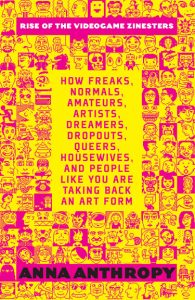 Oakland game creator and author explains how everyone—yes, you!—can make indie video games
Oakland game creator and author explains how everyone—yes, you!—can make indie video games
Anna Anthropy identifies herself as “a freelance scratchware game creator and critic and all-purpose pervert.” Most recently, the Oakland, California-based author released Rise of the Videogame Zinesters: a book about the freedom of the indie videogame world and its artisanal approach to crafting deeply personal and innovative videogames. Anthropy is also the creator of Keep Me Occupied, a site-specific game for the Occupy Oakland rise-up festival that is modeled after the collectivist nature of the Occupy Movement. The game was housed inside a mobile arcade cabinet, called the Oak-U-Tron 201X.
Toronto author, game creator and DIY proponent, Jim Munroe, spoke with Anthropy about zines, indie gaming and her new book.
Jim Munroe: What has been your involvement with zines and zine culture?
Anna Anthropy: I first got involved with self-publishing when I was doing The Gamer’s Quarter magazine in 2005. We were printing pretty thick quarterly journals, and not for cheap — the editor-in-chief was paying out of his own pocket most of the time. But the sense of freedom we had, especially in as closed and incestuous a field as games journalism — a place where favourable reviews are bought, if not with presents, then bought outright. We could run whatever we wanted! Really weird personal stuff that no one was doing at the time. It was a revelation.
I want to do more chapbook kind of zines in the future.
 JM: What sparked your comparison between zines and indie games in your new book?
JM: What sparked your comparison between zines and indie games in your new book?
AA: It hit me when I thought about Gutenberg’s printing press and how important it was to the decentralization of religious authority in Europe. Printing made bibles in German possible, for sure, but it also made pamphlets possible. When I connected self-publishing of text to the self-publishing of videogames, it hit me just how important that is. The games industry is allowed to act as a gatekeeper to games creation because they alone can front the money required to put games on store shelves. But now we have both the means to create games ourselves and the means to distribute them easily — an important part of publishing that the shareware authors of the 1990s struggled with, though they came up with some clever solutions.
I asked myself, what is the printing press of games? GameMaker? The piece of technology that would make widespread creation and distribution of small, personal games possible. Because that’s exactly what people are using this technology to make: zine games! And they’re using the Internet to distribute them — that’s the other critical part of the equation. The problem of distribution without a publisher has been solved.
JM: What do you think of pervy games for mainstream guys, like Leisure Suit Larry?
AA: I like pervy games even for mainstream hetero dudes, because the perversions of the game’s stars are the author’s own. What I want is for games to be more personal, after all. Probably the super-recent Leisure Suit Larry game, if I played it, would turn out to be some really gross college-humour-fest designed for the lowest common bronominator, but what I’ve played of, say, the original soft-porn adventure has loads of personality. Or even something broken and surreal like The Incredible Erotic Adventures of Stiffy Makane.
I am okay with pulp games existing. I consider many of my games to be in a pulp tradition. I love pulp fiction. (To others who do, I cannot recommend more highly the TNT series by Doug Masters.) It’s when pulp b-movies become million-dollar blockbusters that things start to get creepy — when games go from being about the author’s kinks to what a marketer perceives a mainstream audience’s kinks to be.
JM: You say smart things about game design and are well respected for it. But a big part of your persona is also brash and smutty. How has this mix of high and low worked for you creatively and personally?
AA: It works really well, actually! Game dev nerds pay attention to me because they read a blog post or play a game of mine that they found insightful, and then, WHAM! I force them to think about gender and queerness. I feel like I’m an ambassador for queer/trans/kinky/freaky people to folks who are very smart in one way but very sheltered in many others. And I would never tone down the aspect of me that likes to step on girls, because that’s the part that drives my creativity. I don’t allow people to accept one aspect of me and not the other, and in that way I force them to acknowledge that the world is bigger, deeper and wider than they think it is.
JM: Your game on the Oak-u-tron at Occupy Oakland’s march was pretty crazy-awesome.
AA: I’m really happy with how well it’s been received for such a quick, impromptu project! It’s being featured in the upcoming Game Developer Conferences “Experimental Gameplay Sessions,” which is super rad because most of the other games there are probably experimental on a technical level. Keep Me Occupied is a really technically simple game: it was made in two weeks in GameMaker. Anyone could have made it. What’s experimental is the treatment of games as social experiences, connecting multiple people, through experiences designed for and rooted in a specific context. With Keep Me Occupied, that was Occupy Oakland’s move-in day march.
Every social movement has art; every revolution has writers and painters, and more recently filmmakers and photographers. I’m excited that the time has finally come when videogames can take their place in that circle.
Check out Anna’s games and commentary at auntiepixelante.com and stay tuned to Hand Eye Society and Interaccess gallery for news about her upcoming visit to Toronto.
